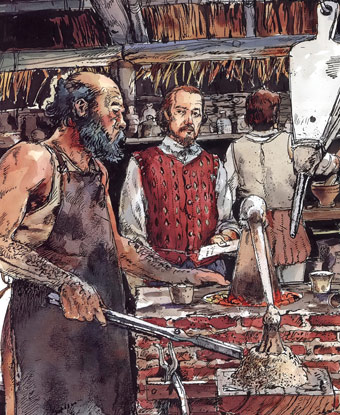Last updated: September 26, 2025
Person
Joachim Gans

National Park Service
Among the many 16th-century English colonists with familiar surnames like Smith, Butler, Berry, Johnson, and Harris, one name stands apart: Joachim Gans. Unlike his fellow voyagers, Gans was not English by birth, but a skilled metallurgist from Prague. Recruited for his expertise, he helped establish a scientific workshop at Fort Raleigh—an extraordinary achievement in a time when science was still fledgling in Europe. Gans is also recognized as the first known Jewish person to set foot in North America, in a time before religious freedom became expected. Yet while his knowledge advanced England’s colonial efforts, his faith placed him at risk. In England where Judaism was outlawed, Gans’ beliefs eventually led to persecution long after his work at Roanoke.
Joachim Gans was born in Prague, which was then part of the Kingdom of Bohemia, in present-day Czechia. There is some indication he may have bene related to David Gans of Prague, a well-known philosopher and astronomer. The first known record of him comes from Cumberland, in 1581. Gans was invited to come to England to help them develop their copper mines in Cumbria. He quickly made improvements to their smelting by creating new methods of “making of Copper, vitriall, and Coppris, and smelting of Copper and leade ures.” He was able to reduce the time needed to purify copper ore from 16 weeks to just four days.
Joachim’s work drew the attention of Sir Walter Raleigh as he began planning colonization efforts in North America. After sending an exploratory voyage in 1584, Gans was recruited to join the 1585 voyage, working alongside scientist Thomas Hariot. They were tasked with leading the scientific exploration of the voyage, looking for deposits of precious metals. Gans’ skills in metallurgy would prove to be useful as the colonists built a metallurgic workshop on the grounds of Fort Raleigh. Through archeology at the site of the workshop, copper deposits, smelting equipment, and more scientific pieces have been found, indicating the type of work Gans would have been doing on Roanoke Island. Due to the ongoing conflicts with the local Roanoke tribe, Gans would leave the island and return to England with most of the other colonists with Sir Francis Drake’s fleet in 1586.
Upon his return to England, Gans worked with the Society of Mines Royal, continuing to advance British mining and smelting operations. In 1589, he was staying in Bristol near the border of England and Wales with other mine workers. A conversation with one of the workers raised suspicion about his religious views. An English bishop, Richard Curteys, came in the inn and was informed that Gans may not believe in the Holy Trinity. He questioned Gans, asking if he denies “Jesus to be the Son of God?” and Gans replied, “What needeth the almighty God to have a son? Is he not almighty?” confirming his Jewish beliefs. The mayor and aldermen of Bristol quickly charged him with blasphemy for his beliefs. England had banned all Jewish people in 1290, and Gans had kept his beliefs secret in the years leading up to his trial. The officials of his case referred it to the Queen’s Privy Council, a body of advisors for the queen. Gans knew several of the advisors on the council, through his work with the Society of Mines Royal. The charge of blasphemy carried a potential death sentence, but Gans wrote to Francis Walsingham, Queen Elizabeth’s spymaster with whom he had worked seeking assistance and protection in his trial. With no known record of Gans in prison or his execution, it appears he may have been released and allowed to leave the country due to his work on England’s behalf.
Joachim Gans may have helped advance England’s colonial ambitions, but he remained a target for suspicion and hostility because of his faith. Gans brought a new understanding of science to England and to North America. The artifacts he left behind at England’s first colony attempt have yielded many clues to their search for mineral wealth in the Outer Banks. The religious freedom others would seek in the New World, along with mineral wealth, was not available to Gans, whose story continues to unfold as more archeology and research reveals more about the first known Jewish person who ventured to North America.
